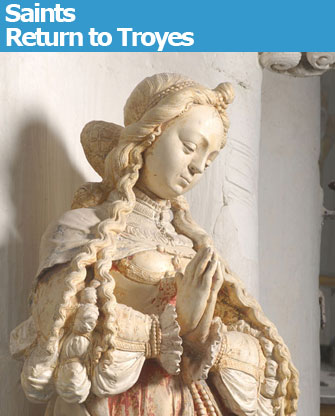 |
| Sainte-Marguerite from the Eglise Saint Laurent in Bouilly © P. Praliaud |
The much-vaunted devolution of France’s cultural riches to the provinces is moving ahead apace, with a branch of the Louvre being built in the northern city of …
 |
| Sainte-Marguerite from the Eglise Saint Laurent in Bouilly © P. Praliaud |
The much-vaunted devolution of France’s cultural riches to the provinces is moving ahead apace, with a branch of the Louvre being built in the northern city of Lens (set to open in 2012) and one of the Centre Pompidou in northeastern Metz (2010). And right now the city of Troyes, a one-and-a-half-hour train ride from Paris, is hosting a world-class exhibition of 16th-century religious sculpture from the surrounding Champagne region, a fine example of a regional show that has both local interest and the quality to attract international visitors.
The works on show through October 25 in the recently restored Eglise Saint-Jean-au-Marché deserve better than the insipid title “Le Beau XVIe,” but no matter. Some 95 statues whose lines were first carved in the Champagne region have temporarily returned to their birthplace from far-flung corners of the world and some of its best museums, including New York’s Metropolitan, the Louvre and the Victoria and Albert in London.
During the 16th century, the Champagne region, a wealthy commercial and cultural center located at the crossroads between Italy, Flanders and Germany, was a hotbed of sculptural creativity. This handsomely displayed show follows the stylistic development during the century from High Gothic to Renaissance and Mannerist styles. It begins with a number of works attributed to the Maître de Chaource (who may have been one and the same as Jacques Bachot), known for a restrained, dignified style that nevertheless conveys strong emotion. Have a look at the subtle expression of tragedy on the face of the Virgin in his “Vierge de Pitié” and the skilful suggestion of the veins in the legs of the dead Christ. The master’s studio was responsible for the powerful crucifix on show from the Eglise Saint-Benoît in Feuges. Many of these works retain much of their original polychrome decoration, while it has been restored on others.
In contrast to the piety and austerity of the Maître de Chaource’s style, the so-called Saint Léger style depicted the Virgin and other holy figures in a rather more worldly way, with a plumpness of flesh and richness of garments that is in harmony with the prosperity of the time and place. One lovely statue of the richly garbed Virgin and Child is so sensitively carved that even such details as the way the mother’s thumb pushes against the Christ child’s clothing as she holds him is realistically depicted.
Another statue in the Saint Léger style, of a bejeweled, round-faced Saint Margaret of Antioch (pictured above), coiffed with long, flowing locks, shows her looking down piously at the dragon who is trying to swallow her whole and already has a piece of her gown in his gaping mouth. Another side of life comes through in a group of rustic wooden statues, almost naive in style, many of which are highly expressive in spite of their roughness. Among so many others, the show also includes elegant statues by Italian sculptor Domenico Del Barbiere, known as Dominique Florentin in France, who lived and worked in Troyes
The wealth of stunning works here is almost overwhelming. Kudos to the organizers for the interesting, truly educational (although hard to read, as usual) labels, and for an impressive kids’ section, complete with related games and authentic period costumes they can dress up in.
A visit to this exhibition makes a perfect day trip from Paris to the lovely city of Troyes, with its many churches and well-preserved half-timbered houses. Click here for more information on Troyes, and here for a restaurant recommendation. See below for info on how to get there.
Eglise Saint-Jean-au-Marché: Place du Marché-au-pain, 10000 Troyes. Trains leave from Paris’s Gare de l’Est. By car from Paris, take the Autoroute A5, exit no. 20, follow signs to “Troyes Centre.” Open daily, 10 a.m.-7 p.m (until 10 p.m. on Fridays in July and August. Admission: €6. Through October 25. www.sculpture-en-Champagne.fr
Buy related books and films from the Paris Update store.
More reviews of current art exhibitions.
Reader reaction
Click here to respond to this article (your response may be published on this page and is subject to editing).
© 2009 Paris Update
Favorite